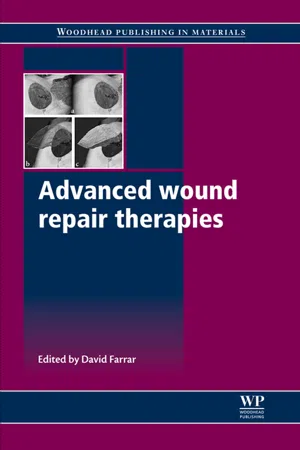
- 672 pages
- English
- ePUB (mobile friendly)
- Available on iOS & Android
Advanced Wound Repair Therapies
About This Book
Wound repair is an important and growing sector of the medical industry with increasingly sophisticated biomaterials and strategies being developed to treat wounds. Advanced wound repair therapies provides readers with up-to-date information on current and emerging biomaterials and advanced therapies concerned with healing surgical and chronic wounds.Part one provides an introduction to chronic wounds, with chapters covering dysfunctional wound healing, scarring and scarless wound healing and monitoring of wounds. Part two covers biomaterial therapies for chronic wounds, including chapters on functional requirements of wound repair biomaterials, polymeric materials for wound dressings and interfacial phenomena in wound healing. In part three, molecular therapies for chronic wounds are discussed, with chapters on topics such as drug delivery, molecular and gene therapies and antimicrobial dressings. Part four focuses on biologically-derived and cell-based therapies for chronic wounds, including engineered tissues, biologically-derived scaffolds and stem cell therapies for wound repair. Finally, part five covers physical stimulation therapies for chronic wounds, including electrical stimulation, negative pressure therapy and mechanical debriding devices.With its distinguished editor and international team of contributors, Advanced wound repair therapies is an essential reference for researchers and materials scientists in the wound repair industry, as well as clinicians and those with an academic research interest in the subject.
- Provides readers with up-to-date information on current and emerging biomaterials and advanced therapies concerned with healing surgical and chronic wounds
- Chapters include the role of micro-organisms and biofilms in dysfunctional wound healing, tissue-biomaterial interaction and electrical stimulation for wound healing
- Covers biologically-derived and cell-based therapies for chronic wounds, including engineered tissues, biologically-derived scaffolds and stem cell therapies for wound repair
Frequently asked questions
Information
Dysfunctional wound healing in chronic wounds
Abstract:
1.1 Normal skin wound healing
| Time | Biological/cellular response |
| 0 Hours | Vascular response initiated and blood coagulation begins. |
| 10–12 Hours | Initiation of new connective tissue formation. |
| 1 Day | Fibrin network formed. Commencement of re-epithelialisation. |
| 3–7 Days | Vascular response has peaked and started to subside. Peak of inflammatory response has been reached. |
| 12 Days | Re-epithelialisation of superficial wounds completed (longer in more extensive wounds). |
| 14 Days | Inflammatory response completed. |
| 6–16 Days | Peak of formation of connective tissue. |
| > 16 Days | Maturation of collagen and remodelling of connective tissue. |
1.1.1 The vascular and inflammatory responses
1.1.2 New tissue formation
Re-epithelialisation
Fibroplasia and wound contraction
Angiogenesis
1.1.3 Tissue remodelling
1.2 Ageing skin and the onset of chronic, dysfunctional wound healing
1.2.1 Skin ageing
Table of contents
- Cover image
- Title page
- Table of Contents
- Copyright
- Contributor contact details
- Introduction
- Part I: Introduction to chronic wounds
- Part II: Biomaterial therapies for chronic wounds
- Part III: Molecular therapies for chronic wounds
- Part IV: Biologically derived and cell-based therapies for chronic wounds
- Part V: Physical stimulation therapies for chronic wounds
- Index